October 13, 2023
Air Date: October 13, 2023
FULL SHOW
SEGMENTS
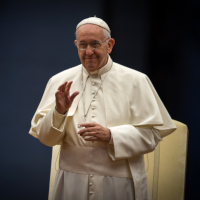
New Climate Writings from Pope Francis
View the page for this story
Pope Francis is back with an even bolder update to Laudato Si’, his climate change encyclical. Christiana Zenner is an Associate Professor in the Department of Theology at Fordham University and joins Host Paloma Beltran to discuss how “Laudate Deum” takes on climate denial and urges the world to act swiftly to avert climate disaster. (14:34)
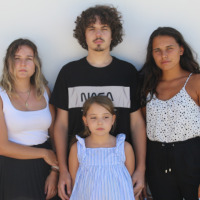
Kids Sue 30+ European Countries on Climate
View the page for this story
Six young plaintiffs from Portugal are suing over 30 European countries they say have violated their rights to life by failing to act on climate change. Patrick Parenteau is an emeritus professor at Vermont Law School and joins Host Jenni Doering to recap the recent hearing in front of a “Grand Chamber” of judges in the European Court of Human Rights and discuss what it could mean for climate action. (10:51)
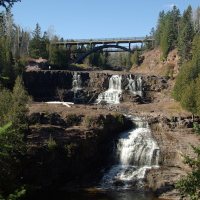
Beyond the Headlines
/ Peter DykstraView the page for this story
This week, Living on Earth Contributor Peter Dykstra joins Host Paloma Beltran with a couple of warnings from scientists about how the warming planet is affecting species, from brook trout that may get wiped out from streams in the Great Lakes region to mother polar bears who can’t make enough milk because of shrinking Arctic sea ice. In history, they look back to 1988, when three gray whales stuck in the ice captured the world’s attention. (04:40)
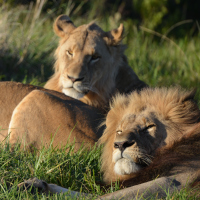
Note on Emerging Science: Social Mammal Longevity
View the page for this story
A recent study found that mammals that live in groups tend to live longer than solitary mammal species, even after accounting for other factors. Living on Earth’s Don Lyman explains why being social appears to benefit members of a group and help them live longer. (02:23)
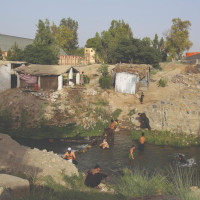
Toxic Toll of the War in Afghanistan
View the page for this story
The 20-year U.S. war in Afghanistan brought tens of thousands of direct casualties but also dangerous pollutants that survivors are still living among. Lynzy Billing reported from Afghanistan for Inside Climate News and New Lines Magazine and joins Host Jenni Doering to describe the hazards and health problems some Afghans link to the war. (13:20)
Show Credits and Funders
Show Transcript
231006 Transcript
HOSTS: Paloma Beltran, Jenni Doering
GUESTS: Christiana Zenner, Pat Parenteau
REPORTERS: Peter Dykstra, Don Lyman, Lynzy Billing
[THEME]
DOERING: From PRX – this is Living On Earth.
[THEME]
DOERING: I’m Jenni Doering.
BELTRAN: And I’m Paloma Beltran.
Pope Francis is back with another manifesto on climate.
ZENNER: The Catholic Church can assess developments in science and either refuse to engage the questions raised, or say this looks like a big issue, what does this mean for theology, for morality, and for the project of being human? And that's what the Pope has chosen to do.
DOERING: Also, Afghan people face hazards left behind by the US military.
BILLING: The waste really wasn't their priority at the time, and they were fighting a war. And there was no laws or any prohibitions, really, from a US military perspective, or international perspective, that was stopping them from dumping in waterways and fields and land or burning in areas around.
DOERING: That and more, this week on Living on Earth – Stick Around!
[NEWSBREAK MUSIC: Boards Of Canada “Zoetrope” from “In A Beautiful Place Out In The Country” (Warp Records 2000)]
[THEME]
New Climate Writings from Pope Francis
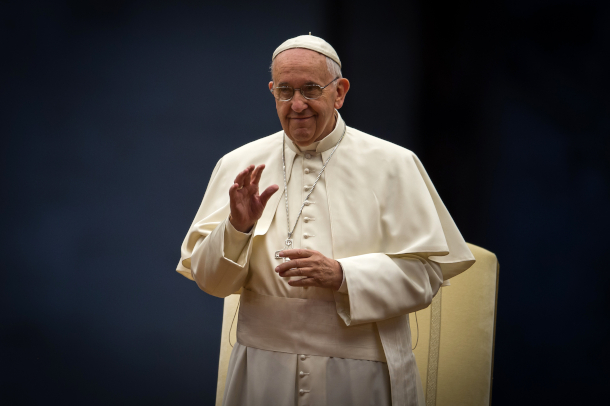
Pope Francis wrote his first papal document on the environment, Laudato Si’, in 2015. (Photo: Catholic Church England and Wales, Flickr, CC BY-NC-ND 2.0)
DOERING: From PRX and the Jennifer and Ted Stanley Studios at the University of Massachusetts, Boston this is Living on Earth. I’m Jenni Doering.
BELTRAN: And I’m Paloma Beltran.
In June 2015, Pope Francis published a groundbreaking document that made a theological case for climate action called Laudato Si’: On Care for Our Common Home. That fall, in a rare moment of unity, nations established the landmark Paris Climate Agreement. Now, eight years later, the Pope is back with an even bolder update. In “Laudate Deum”, or “Praise God”, Pope Francis says the world is “nearing the breaking point,” condemns climate denial, and calls for urgent climate action. The Roman Catholic church he leads is the largest Christian denomination and has over a billion followers around the world. Christiana Zenner is an Associate Professor in the Department of Theology for Fordham University who is currently working on a book about the Pope’s writings on the climate.
ZENNER: This document is a total zinger compared to Laudato Si'. So whereas Laudato Si' in 2015, was extensive, it was quite long, it was measured and pastoral and expressive and philosophical. This document, Laudate Deum, is much shorter. And it is super focused on the realities of climate crises, the realism of climate change, anthropogenic climate change in particular, as a moral, ecological social problem, and on the responsibility of all people to take up action in order to address these problems. So there's a lot of really specific citation of science, there is a lot of very specific invocation about the kinds of things that need to happen. And then there is a little bit of philosophical and theological framing. But it's a really punchy document. And in some points, it's actually even a little bit snarky. He's saying to very high consuming nations, and specifically the US, he calls out the US explicitly in the penultimate paragraph of the exhortation. He says the rates of consumption are so far above China, and even more profoundly above peoples and nations that are far less developed. And so he's really taking language that is similar to the Kyoto Protocol and other kinds of agreements that see consumption by particular nations as historically problematic and in an ongoing way. It's also I think, taking pretty specific aim at the US Conference of Catholic Bishops and climate denialists. As you may know, the US Conference of Catholic Bishops has been pretty focused on pelvic issues, on abortion and contraception, etc, as its primary moral focus. And I think that it's no accident that the Pope uses a US Bishop's document from 2019 on climate change as the first citation, and then ends the document with this throwdown about US consumption. I think that's a pretty substantial frame.
DONNA HARAWAY is cited in #LaudateDeum. Wow. I never thought I would see a woman in the FN, and it’s Haraway!https://t.co/hdPLJr7XQ1
— Christiana Zenner (@christyzen) October 4, 2023
BELTRAN: It seems like Pope Francis is not beating around the bush when it comes to climate change.
ZENNER: Oh, he is not. This is a throwdown document. It's really a zinger. So he's also then, especially in the first part of the apostolic exhortation, talking about climate denialism. And just taking it down, point by point. He just says, no, this doesn't hold, this is not tenable. This is not a Catholic point of view, it's not even a reasonable point of view. And let me show you why. And so in a very effective way, he just critiques those arguments. So for example, he says that in recent years, some have chosen to deride these facts, he's speaking of climate change. Then he says, they'll bring up the allegedly solid scientific data, like the fact that the planet has always had and will have periods of cooling and warming. But then he goes on to say, they forget to mention another relevant datum, that what we are presently experiencing is an unusual acceleration of warming at such a speed that it will take only one generation in order to verify it. And he does this a number of times, this language that is basically some claim, or some deride these facts, and they'll present this kind of claim, but they forget to include this other additional claim. And so in a way that is rhetorically powerful and philosophically grounded, he's calling those folks to task and saying your philosophy is bad and your science is too. Get with it.
BELTRAN: So what does this document say about the connection between the Catholic Church and the scientific world?
ZENNER: One of the things that's really interesting, and in many respects great about the Catholic Church is that in the late 20th century especially, it has had a pretty robust engagement with contemporary sciences of the time. And this document continues that trend. So if you look at the citations, like scholars love to do, if you follow the footnotes, there are tons of citations of the Intergovernmental Panel on Climate Change, these kinds of consensus documents that indicate the patterns, extent, and implications of anthropogenic climate changes. And so not only are those in the footnotes supporting a range of claims, there's also explicit numbers throughout the document. So I would say there's a huge relationship between the Catholic Church and science in this document. Because a lot of people think, oh, Catholic Church. Science. Well, Galileo, that didn't go well. But when we delve into it, you know, absolutely, yes, lots of problems going on in that era for sure. But there are also always really interesting moments that religious institutions, in this case, the Catholic Church, can assess developments in science and either hunker down and refuse to engage the questions raised, or say, wow, this looks like a big issue. What does this mean for theology, for morality, and for the project of being human? And that's what the Pope has chosen to do.
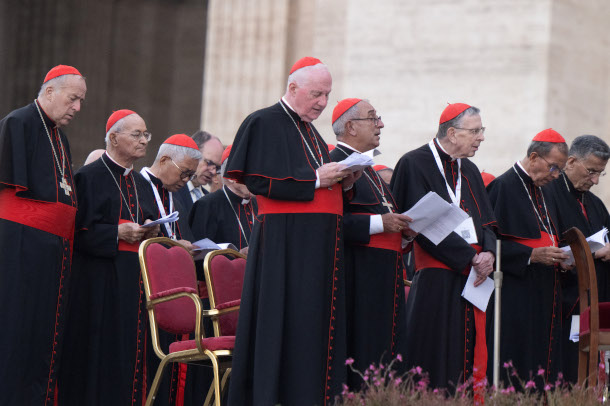
The Pope’s exhortation was published at the open of October 2023’s Synod of Bishops in the Vatican. (Photo: Catholic Church England and Wales, Flickr, CC BY-NC-ND 2.0)
BELTRAN: Christiana, what surprised you the most about Laudate Deum?
ZENNER: What surprised me the most? Well, I think there are a few things. One is how pithy and direct it is. The Pope knows what he's doing in this. And the structure of the apostolic exhortation, as well as the tone is remarkably direct, very readable, and, in many ways, at least from an interdisciplinary ethics perspective, irrefutable on the dynamics of climate change, and the science behind it, economic growth presumptions and the dynamics of consumerism, and what Pope Francis calls in a slightly more philosophical and theological way, the technocratic paradigm, which is a fetishization of economic efficiency and technological innovation. The presumption that those alone will solve ecological or social problems. So I was really, frankly stunned and really happy to see someone who is in a position of authority, yes, in a hierarchical patriarchal context that has massive problems. But as we saw in the reception of the 2015 Laudato Si' document, he's in a position to get people's attention. Another set of things that surprised me and didn't. There's one citation in there, citation 41, of feminist philosopher of science, Donna Haraway. She's an American, a long standing professor at the University of California Santa Cruz, someone who's been very critical of normative gender hierarchies as they play out in the practice and conceptualization of science, and a real advocate for multi-species relations. So she shows up in footnote 41, which is shocking, because she's on record as being anti-Catholic, anti-institutionally-Catholic, and anti-theistic in that sense. So, how on earth did this citation get into the apostolic exhortation? And what does it mean? I am fascinated and a number of us are trying to dig into this.
BELTRAN: So Pope Francis cited Donna Haraway, what did he say there?
ZENNER: So she is cited in a section on anthropocentrism. The idea that humans are at the center functionally, as well as morally, of the earth and of theological significance. And so Pope Francis says, the technocratic paradigm, which he had earlier critiqued, can deceive us by making us forget that the entire world is a contact zone. And he cites this book by Donna Haraway, called When Species Meet. And then the section goes on to talk about well, we can't have like a full anthropocentrism where humans are the only or exclusive focus, we need a situated anthropocentrism that recognizes the interrelations and the limits to human centrality and power. It is completely fascinating that the Pope chooses to cite her or the Pope's ghost writers, don't know which one. But it's kind of a two part thing. There's that whole reaction of oh my gosh, what on earth? And then the second part is, isn't it interesting, that of all the women to cite, all of the experts who happen to be women, the one he cites is Donna Haraway. And not the many, many, many women within the Catholic Church. Celia Deane-Drummond, Brazilian ecofeminist liberation theologian Ivone Gebara, there are so many brilliant scholars who are women who have been working with eco-theologies and orders of nuns who have been implementing ideas like this that far preceded even Laudato Si' in 2015. So the citation of Haraway is doubly bizarre. Because why not cite women who are also engaging the work of the church? And one skeptical answer is, well, there's a long history of excluding them. And maybe it would mean that their critiques would have to be taken seriously. I don't know. But it's one viable hypothesis.
BELTRAN: In Laudate Deum, Pope Francis specifically discusses COP28, the United Nations Climate Change Conference. What do you make of these mentions?
ZENNER: I think it's really interesting and exciting that Pope Francis is focusing this document on COP28. So clearly, this document is meant to have a practical political lifestyle impact. And what I think is so distinctive about his approach in Laudate Deum, this 2023 document is that he has a whole section on COP28. And he says that if we are confident in the capacity of human beings to transcend their petty interests, and to think in bigger terms, we can keep hoping that COP28 will allow for a decisive acceleration of energy transition with effective commitments subject to ongoing monitoring. And he goes on, he says, there needs to be binding forms of energy transitions that meet three conditions: efficient, obligatory, and readily monitored. And then he later says, and everyone needs to commit to them, it can't just be a kind of exceptional thing. So I think this is, this is pretty remarkable, because he's basically saying, here's what you guys need to do: get it together. And in Section 58, he has a defense of climate activists. This is really important, because around the world, we're seeing the silencing and the jailing of climate activists in a range of contexts. And so into that space, Pope Francis says in paragraph 58, in conferences on the climate, the actions of groups negatively portrayed as radicalized, radicalized is in quotes, tend to attract attention. But he continues, in reality, they are filling a space left empty by society as a whole, which ought to exercise a healthy pressure. So this idea that there's need for what he calls a multilateralism from below, that the voices of activists, the voices of people affected by these things, that this matters, I think, is really, really significant.
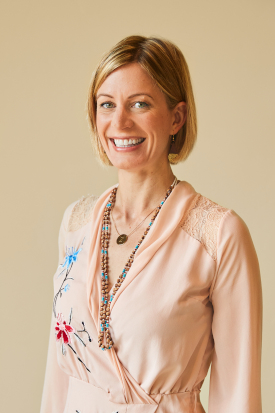
Christiana Zenner is an associate professor at Fordham University’s department of theology. (Photo: Courtesy of Christiana Zenner)
BELTRAN: And after the Pope has written and published this, what happens next? What are Catholics expected to do with this?
ZENNER: On the one hand, it's in the written record, the Vatican archives, as a pretty authoritative document, that anyone in the world or anyone of goodwill, who is the intended audience of this document according to Pope Francis, that anyone in the world can access. I think it will be a resource for nonprofit organizations and branches of the church and parish communities who really want to take up the call to reflect theologically and in terms of ethical action, and maybe even in terms of activism. I don't know how priests and other formal representatives of the church, especially in the United States will engage it. I think that's one of the questions that remains to be seen. But as I've said, it's a pretty fascinating, concise, pithy zinger of a document that is doing something exciting, so I'm interested to see what happens with it.
BELTRAN: Christiana Zenner is an associate professor of theology, science and ethics at Fordham University. Christiana, thanks so much for taking the time with us today.
ZENNER: Thank you for having me.
Related links:
- Pope Francis’ “Laudate Deum” apostolic exhortation
- Listen to our interview with Christiana Zenner on Laudato Si’ in 2015
- About Christiana Zenner
[MUSIC: The London Mozart Players and Pegasus Chamber Choir/Robert Lewis, featuring Cai Thomas, Recording session for “Seren” - at St. John the Evangelist in Croydon, September 2019, by Wolfgang Amadeus Mozart, later released on Rubicon Records]
DEORING: Coming up, youth plaintiffs in Portugal sue over 30 European nations over climate inaction. Stay tuned!
ANNOUNCER: Support for Living on Earth comes from Sailors for the Sea and Oceana. Helping boaters race clean, sail green and protect the seas they love. More information @sailorsforthesea.org.
[CUTAWAY MUSIC: Frankfurt Radio Symphony and Frankfurt Radio Big Band live! hr-Sinfonieorchester – Frankfurt Radio Symphony Marc Gruber, Horn Elias Grandy, Coductor Wolfgang Amadeus Mozart: Horn Concerto E-flat major K. 495 (Appearance) 00:00 I. Allegro moderato 00:34 II. Romanza. Andante cantabile 09:54 III. Rondo. Allegro vivace]
Kids Sue 30+ European Countries on Climate
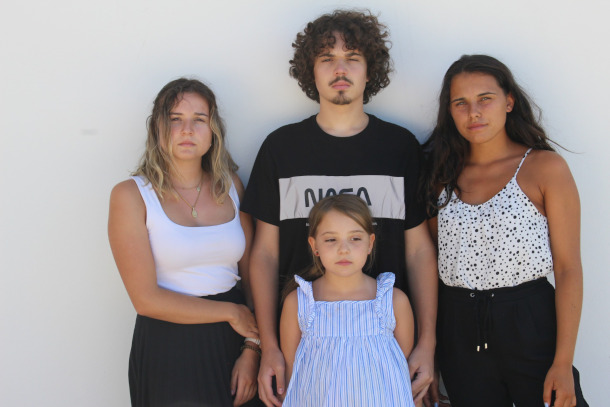
Four of the six youth applicants, now aged 11-24, are from the Leiria region of Portugal, which experienced deadly forest fires in 2017. (Photo: Global Legal Action Network)
BELTRAN: It’s Living on Earth, I’m Paloma Beltran
DOERING: And I’m Jenni Doering.
After enduring years of punishing heat waves and out of control wildfires, in 2020 six young people from Portugal filed a lawsuit against over 30 European countries. The youth plaintiffs say that by failing to act on climate change, these countries have violated their rights to life and family security, as guaranteed by the European Convention on Human Rights. And on September 27 of this year, these young people and their lawyers finally made their case in front of a “Grand Chamber” of 17 judges at the European Court of Human Rights in Strasbourg, France. Patrick Parenteau is an emeritus professor at Vermont Law School, and he’s here to walk us through what this case might mean for climate litigation around the world. Welcome to Living on Earth, Pat!
PARENTEAU: Thanks, Jenni, good to be with you.
DOERING: So what are these youth plaintiffs saying that these 32 countries have failed to do?
PARENTEAU: They're basically saying the countries are not living up to their commitments to take meaningful action to reduce emissions. And they're using as their benchmark, the Paris Agreement goal of holding temperatures below 1.5 degrees Celsius, and certainly not exceeding two degrees Celsius. So the plaintiffs are saying, you need to take more aggressive action to reduce these emissions in every sector. And they've laid out a plan for how to do that. It's a comprehensive case, in the sense of the first time you're suing a group of countries that large. No other case has ever done that. And it's in front of a court that has the power to order these countries to take action. So that's what makes it such an important case.
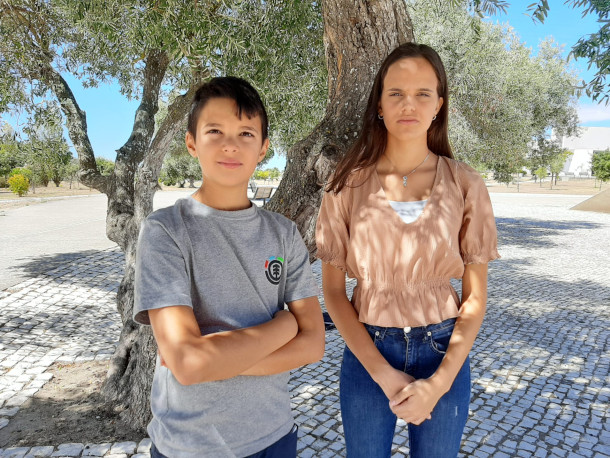
The other two youth applicants, Andre and Sofia, now aged 15 and 18, are from Lisbon, Portugal. (Photo: Nuno Gaspar de Oliveira)
DOERING: At the hearing in this case, on September 27, the judges heard oral arguments from both sides. What were some of the main questions raised there?
PARENTEAU: Three main issues. The first and most important one is whether this court actually has jurisdiction to adjudicate the claims that the young plaintiffs, they're called applicants, are bringing. And the convention is aimed at ensuring protection of human rights within the individual countries. In this case, it would be Portugal. And the central question is whether the court is actually going to take jurisdiction over actions and inactions that are occurring in these other states. In the past, this court has been very restrictive. So will this court break from some of its earlier precedents and extend its jurisdiction to cover all 32 nations that have been sued in this case?
DOERING: That sounds like a lot of power for one court, Pat.
PARENTEAU: It is a lot of power. And it also will mean the court will be injecting itself into the whole realm of global action required to deal with climate change. And in fact, one of the big arguments from these 32 countries is, you need to stay out of this and leave this to the United Nations Framework Convention on Climate Change, the Paris Agreement, and the COP meetings. That's the forum where all of these issues need to be addressed in a collective way, globally. This court should not insert itself into that process and start ordering individual countries to do things that are different from what's being negotiated in these international treaty negotiations. So that is a big issue.
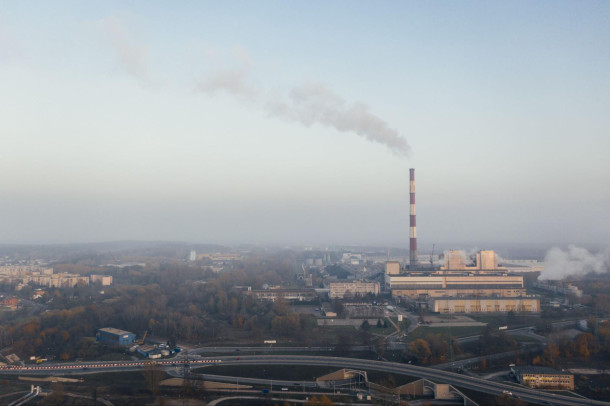
These young people are suing 32 countries, saying their failure to curb greenhouse gas emissions has violated the applicants’ human rights. (Photo: Marcin Jozwiak, Pexels)
DOERING: So tell us about the second issue that was raised in this hearing.
PARENTEAU: So the second issue is what we in the United States would call the requirement to exhaust administrative remedies. And what that means in this context is these youth plaintiffs should have gone to courts in each country, all 32, starting with Portugal, and attempted to get relief from their domestic courts. So that's what exhaustion means. Go to your own courts first. And if you're not successful there, then you can come to the Human Rights Court. The response to that, which I found persuasive, was number one, it's not clear that any of the countries have an established pathway to obtain the relief we're seeking, which is action equivalent to holding global temperatures below 1.5 Celsius increase. Number two, it would be extremely costly to bring lawsuits in 32 countries. And number three, it would take an inordinate amount of time to do that. And of course, we don't have that kind of time. We need to be acting now. So their response to the exhaustion is, it would be futile.
DOERING: So you mentioned there's three main questions. What was the third?
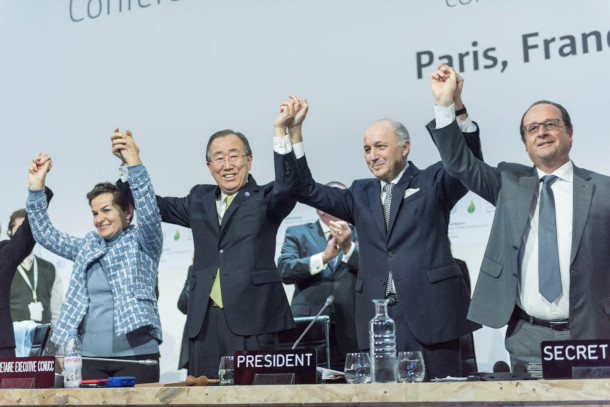
The Paris Climate Agreement’s goal is to keep global average temperatures below 1.5 degrees Celsius above pre-industrial levels. The youth applicants allege countries are not doing enough to meet that target. (Photo: UN Photo, Flickr, CC BY-NC-ND 2.0)
PARENTEAU: The third issue is whether these youth plaintiffs can prove standing. The European law uses different terminology, victimhood, and it has to do with how direct and individualized must the harm be in order for an applicant to have standing. These youth plaintiffs were able to demonstrate that they are experiencing harms that are not unique to them, right? Everyone in the world is experiencing the effects of climate change to varying degrees. But what these plaintiffs are saying is, Portugal represents a particularly dangerous situation. And our conditions are exaggerated. They may not be different in kind, but they're different in degree. The declarations in this case, for example, talk about how the students are not allowed to leave class. Some of their schools have been shut down. They can't engage in athletic activities, simply because of the heat. It's just simply so hot, that you can't function in a normal way. How do you conduct day to day activities, when the temperature is such that the medical science is telling you, you're risking heatstroke every day throughout the summer?
DOERING: It doesn't sound like much of a childhood, Pat, you know, no recess, no playtime outside.
PARENTEAU: That's right. And they had medical testimony presented to that very point, it was both physical impacts on the children, and mental. And this is just the beginning. The potential harm is much worse, unless much stronger action is taken to reduce emissions and provide for adaptation.
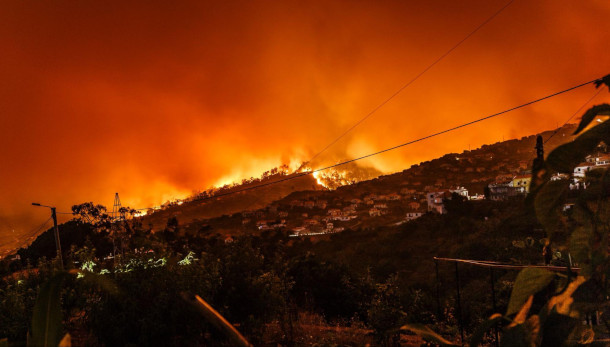
Over the past decade, Portugal has faced severe wildfires and heat waves, which will continue to be exacerbated by climate change. (Photo: Michael Held, Unsplash)
DOERING: You know, just on the question of how much time there is for these plaintiffs to act and for these countries to act, the IPCC has said that we have to basically halve our carbon emissions globally, by the end of this decade, like six years away, Pat.
PARENTEAU: Right. And the lawyers for the youth plaintiffs made a big point about how rapidly the nations in Europe and elsewhere have to move in order to meet their commitments under the Paris Agreement. We're way behind. They actually presented evidence from an entity known as the carbon action tracker, or CAT. And it's very quantitative evidence of what each individual nation's fair share would be in terms of reducing emissions. So they've laid out a blueprint. Again, if the court decides to take this case on, and if it decides to genuinely engage with the question of what exactly is your legal obligation, each and every one of you, this will be a dramatic breakthrough for climate change. It's pushing the boundaries of how far courts should go when you have a problem of this nature. But it certainly is an opportunity for the court to put down a very strong marker here. And we'll see if it does it.
DOERING: Right, because the Paris Climate Agreement, if I understand it correctly, is not actually legally binding. And so it sounds like this decision from this court may actually put some teeth behind that.
PARENTEAU: You're exactly right, Jenni. The Paris Agreement sets goals, but it doesn't impose binding targets. It does have binding procedural obligations, like disclosing what your emissions are. But when it comes to limiting global warming to 1.5 or two degrees Celsius, no, that's not a legally binding obligation. That's their ultimate goal in this case, is to make that 1.5 degree limit legally enforceable throughout the European Union countries to start with. And then hopefully, beyond that. This court does have the power to issue a legally binding order, if they're willing to do it.
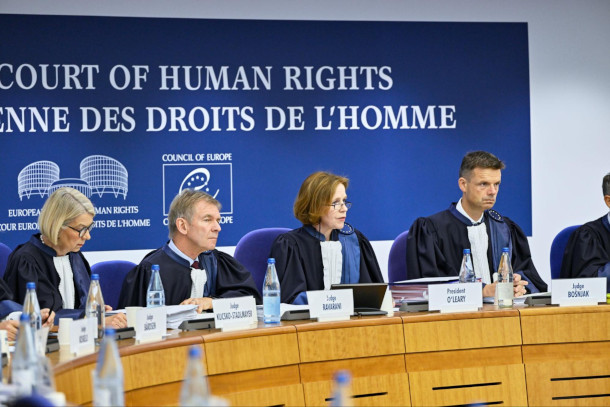
The case was heard in front of the Grand Chamber, which includes 17 judges from 17 different countries. (Photo: Council of Europe)
DOERING: Pat, we've seen a lot of youth climate cases hit the headlines here in the US. To what extent are we seeing a global pattern here?
PARENTEAU: The number of human rights based cases, and the number of cases being brought by youth plaintiffs is steadily increasing both in the United States and elsewhere. So it's a sign, of course, that the governments, who are ultimately responsible, that political process, is not responding to the crisis in the way that's necessary. And more and more people are turning to the courts. And they're seeking ever, in my view, sophisticated and innovative remedies and arguments and theories. I mean, they're pushing the law. Climate change is pushing the law. Climate change is going to push this court, I think, in the direction of issuing something, hopefully, positive in this case.
DOERING: Patrick Parenteau is an emeritus professor at Vermont Law School. Thank you so much, Pat.
PARENTEAU: Thanks, Jenni. Always a pleasure.
Related links:
- More on the court case
- Lean more about Patrick Parenteau
[MUSIC: Dave Matthews and Tim Reynolds, “One Sweet World” on Live at Luther College, by Dave Matthews, BMG Entertainment]
Beyond the Headlines
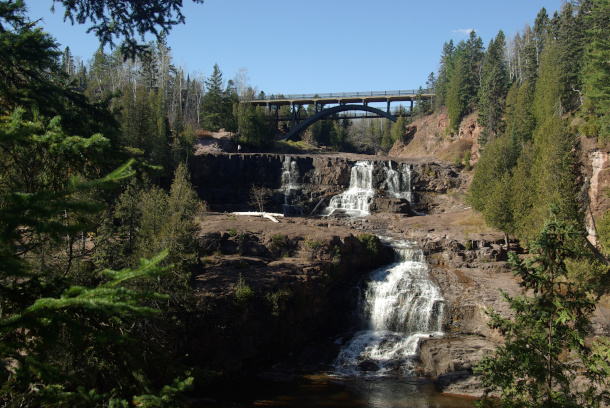
The northern shore of Lake Superior may be getting too warm for brook trout. (Photo: aaronHwarren, Flickr, CC BY-ND 2.0)
BELTRAN: It's just about that time for a look beyond the headlines with our Living on Earth contributor Peter Dykstra. He's joining us now from Atlanta, Georgia. Hey there, Peter, how are you?
DYKSTRA: I'm doing well. Paloma. And I hope you're doing well, too. Here's the story about a species that may not be doing well a prized species for sport fishermen in the uppermost part of the U.S. side of the Great Lakes, as the Great Lakes warm, some of the feeder streams along the Minnesota coastline may be getting too warm for brook trout to survive.
BELTRAN: And from what I understand the Great Lakes have over 150 native fishes, and it's huge for sport fishing. What are natural resource managers going to do about this?
DYKSTRA: Well, natural resources managers alone can't do a whole lot about water getting warmer. But by mid century, the researchers say about a third of the streams in the area studied, the way far North Lake Superior shoreline and Minnesota, will be too warm to host the brook trout.
BELTRAN: Just another unfortunate impact of the climate crisis. Hmm. What else do you have for us, Peter?
DYKSTRA: Something else that's also not good news and something from another cold region. Polar bears might be further affected by climate change. We already know that declining ice is a problem. But that declining ice drives mother polar bears onto land. And when those polar bears nurse where no polar bear food is available on land, there's a problem with raising young polar bears. It's a study published in the Marine Ecology Progress series saying that lactation is quote, "negatively affected by increased time spent on land when the sea ice melts", which we all know is happening very quickly in the Arctic.
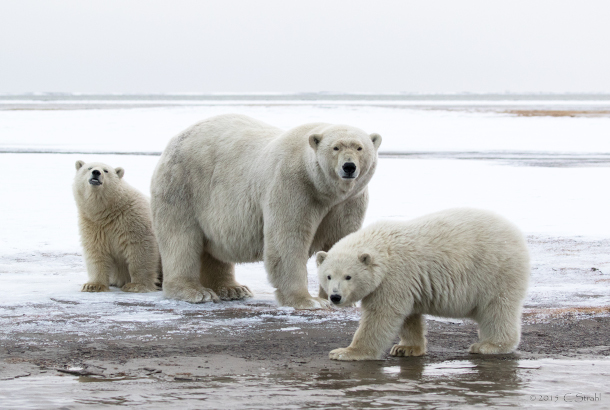
A mother polar bear stands with cubs on Barter Island off the north slope of Alaska. (Photo: Cheryl Strahl, Flickr, CC BY-NC 2.0)
BELTRAN: Well, I've seen images of struggling mother polar bears, and they're just heartbreaking
DYKSTRA: It is. And it was thought that that was simply due to a lack of food. This is some scientific evidence that that lack of food for nursing polar bear mothers is essentially doubling the impact on the polar bear species.
BELTRAN: And is there warmer news in the history section?
DYKSTRA: I'm afraid not just a story from Alaska to go along with our stories from Minnesota and Canada. On October 13th 1988, there was a cameraman for the North Slope borough. That's where the town of Barrow is — the center for the oil industry. North Slope borough got so much money from the oil industry that they were able to build a state of the art satellite uplink, and outfit cameraman. Bear in mind this is 1988. There are places a lot bigger that didn't have such equipment. The cameraman was offshore in a snowmobile when he spotted three gray whales stuck in the ice, breathing through a small lead — a small hole in the ice —apparently stuck and potentially dying. When that ice closed up. There was a frenzy to save these three whales. Those pictures ignited this global rescue effort that included the Soviet Union in its last years sending a nuclear powered icebreaker. Two of the three whales are known to have survived. The third one is suspected to have died. And in the end, what came out of it was a major motion picture in 2012 called the Big Miracle, starring Drew Barrymore as Cindy Lowry, one of the heroines in the movie version. It's a great story. Not so great a movie, but there's a catch to all of this.
BELTRAN: What's the catch?
DYKSTRA: At least 100 gray whales, it's believed, die this way every year. These three gray whales happen to get stuck in the ice in front of a video camera and a video uplink for the whole world to see.
BELTRAN: Peter Dykstra is living on Earth contributor. Thank you so much. And we will talk to you again real soon.
DYKSTRA: Paloma, thank you, and we'll talk to you soon.
BELTRAN: And there's more on the stories on the Living on Earth website. That's loe.org.
Related links:
- Bridge Michigan | “In Warming Great Lakes, Climate Triage Means Some Cold Waters Won’t Be Saved”
- The Conversation | “Polar Bears May Struggle to Produce Milk for Their Cubs as Climate Change Melts Sea Ice”
- Read more about the gray whale rescue
[MUSIC: Keola Beamer, “Dancers in the Land of Po” on Wooden Boat, by Keola Beamer, Dancing Cat Records]
BELTRAN: Just ahead, the long U.S. war in Afghanistan left water, air, and land polluted. Keep listening to Living on Earth.
ANNOUNCER: Support for Living on Earth comes from Friends of Smeagull the Seagull And and Smeagull’s Guide to Wildlife. It’s all about the wildlife right next door to you! That’s Smeagull, S - M - E - A - G - U - L - L, SmeagullGuide.org.
[CUTAWAY MUSIC: Louis Armstrong and His All Stars, “All That Meat and No Potatoes” on Satch Plays Fats, by F. Waller and E. Kirkeby, Sony Music Entertainment]
DOERING: If you enjoy the stories you hear on Living on Earth, please consider signing up for our newsletter. You’ll never miss a show, and you’ll have special access to show highlights, notes from our staff, and advanced information about upcoming live events. The Living on Earth newsletter is sent to your inbox weekly. Don’t miss out! Subscribe at the Living on Earth website, loe.org.
[MUSIC: Keola Beamer, “Dancers in the Land of Po” on Wooden Boat, by Keola Beamer, Dancing Cat Records]
Note on Emerging Science: Social Mammal Longevity
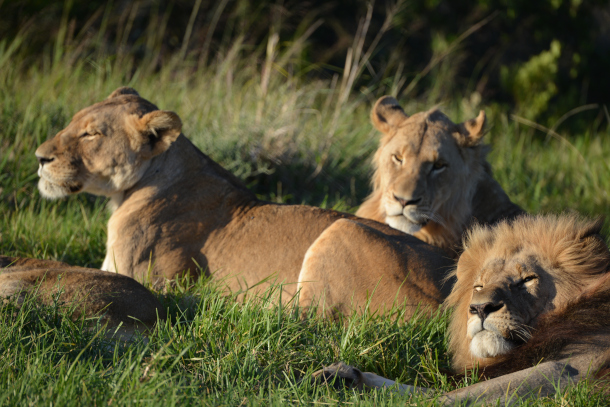
Lions form social groups known as ‘prides’. (Photo: SenatorCMP, Flickr, CC BY-NC-ND 2.0)
BELTRAN: It’s Living on Earth, I’m Paloma Beltran.
DOERING: And I’m Jenni Doering.
So Paloma, last week we mentioned that voting for Fat Bear Week was underway and we now have a winner!
BELTRAN: Ooh! Who won this year?
DOERING: Fans crowned 128 Grazer as the champion. She’s a mom to five cubs and almost 20 years old.
BELTRAN: Congrats to Grazer! Sounds like she’s ready to survive the long winter. Now on to some mammals who are even more long-lived in this note on emerging science from Don Lyman.
[SCIENCE NOTE THEME]
LYMAN: Maximum lifespans of mammals range from about two years for some shrew species to upwards of 200 years for bowhead whales. But researchers who analyzed the lifespans and sociality of over 900 species of mammals, recently reported that species that live in groups, like horses and chimpanzees, tend to live longer than solitary species, like weasels and hedgehogs. Evolutionary biologists from the Chinese Academy of Sciences in Beijing analyzed information from the scientific literature on the social organization of the 974 mammal species by dividing them into three categories: solitary, pair-living, and group-living. The researchers then compared the three categories with data on the mammal species’ longevity. They discovered that the mammals that lived in groups tended to live an average of 22 years, while the solitary mammal species lived about 12 years.
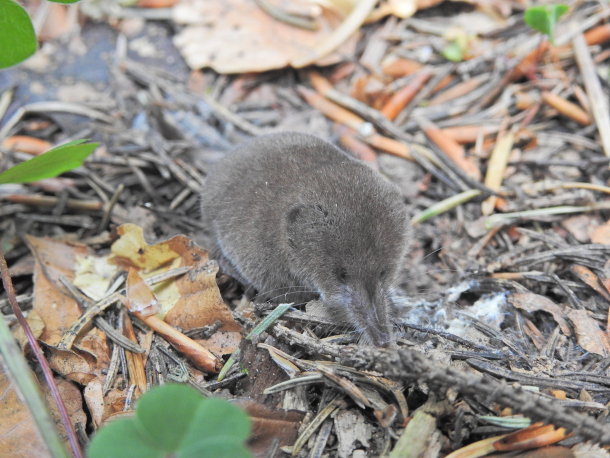
Shrews are solitary mammals. (Photo: Xulescu_g, Flickr, CC BY-SA 2.0)
Bigger mammals generally live longer than smaller species, so the researchers then accounted for body mass, but they found that the effect of sociality still conferred longer lifespans. One example was that of similarly small shrews and bats. The scientists found that the solitary shrews lived only a few years, while some social bat species lived 30 or 40 years.
The researchers were surprised by their findings, because individuals that live in groups face potential costs, such as competition for mates and for food, as well as the spread of infectious diseases. But the scientists also noted the benefits of living in a group, such as protection against predators, as well as group foraging for food which might decrease the chance of starvation. These benefits might increase the length of social mammals’ lives.
The researchers also speculated that the evolution of long lives might be more likely in species that live in groups because the group members might aid the survival of their family members, which carry their genes.
That’s this week’s note on emerging science. I’m Don Lyman.
Related link:
Learn more about Don Lyman
[SCIENCE NOTE THEME]
Toxic Toll of the War in Afghanistan

Outside the Jalalabad airfield, residents wash in the stream that flows from a hole in the high wall surrounding the base. (Photo: Lynzy Billing)
DOERING: The war in Afghanistan was the longest the U.S. military has engaged in with the last of American troops withdrawing in 2021. Over twenty years, the U.S. military dropped tens of thousands of bombs in Afghanistan and more than 70,000 Afghan and Pakistani civilians died as a direct result of the war. The prolonged conflict also left many Afghan people without adequate food, clean water, and shelter, making them vulnerable to natural disasters including the devastating earthquakes that have taken thousands of lives in recent days. But there is another cost to the war that is often overlooked. Afghan civilians are now living among dangerous pollutants left behind in the wake of the fighting, according to reporting from Lynzy Billing. She’s a freelance journalist who was born in Afghanistan and dug into this for our media partner Inside Climate News and New Lines Magazine. Lynzy, welcome to Living on Earth!
BILLING: Thank you for having me.
DOERING: So we often think of the direct injuries that bombs and other weapons can inflict during a war, but they can also leave behind dangerous chemicals. So what kinds of toxic substances can munitions have?
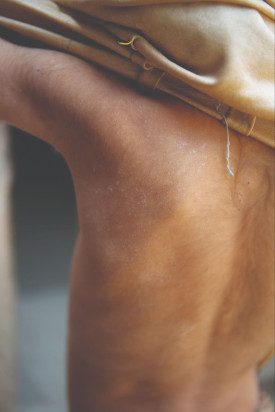
Many weapons leave harmful residues in their wake, such as the carcinogenic explosive RDX. In the Achin district where MOAB, or the Massive Ordnance Air Blast, was dropped by US forces in 2017, residents believe their skin rashes are caused by the bomb’s chemical legacy. (Photo: Lynzy Billing)
BILLING: Yeah, I think that beyond the obvious impacts of the bombs and weapons during the American war in Afghanistan, there was a longer lasting effect that came with the war. And that really is the chemicals and residue attached to these weapons and munitions. If we're speaking about bombs alone, tens of thousands of bombs were dropped on Afghanistan over the last 20 years. And most of these included explosives like RDX. And RDX has been described as being potentially carcinogenic. You know, those landmines that are still in waterways, there's a whole array of munitions that are left behind. But it's also the bases themselves, the military bases, and their waste disposal practices, and their activities during the war that also left behind the environmental effects that really we haven't had a chance to look at properly until now. I think I really wanted to get away from just talking about the weapons that are still left half buried or uncovered and really look at the longer lasting health impacts from the war in general, which are in soil and are in water and in the air and in people's food and what they eat and drink from on a daily basis.
DOERING: You reported that the US military consistently dumped sewage into agricultural fields where Afghan people were growing their food. What pollutants were in that sewage, and what kinds of impacts did that have?
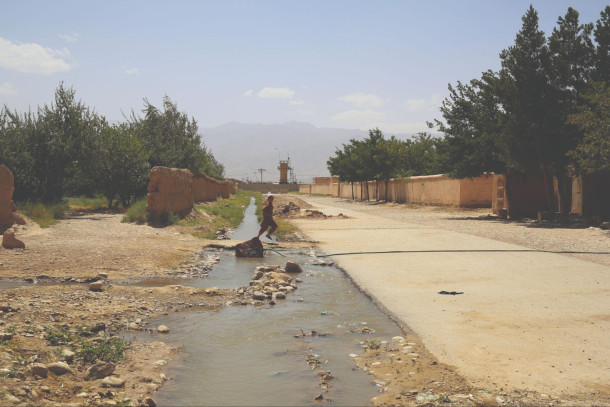
Many residents living near US military bases in Afghanistan say tankers would dump sewage waste directly into waterways. (Photo: Lynzy Billing)
BILLING: Yeah, one of the things that kept coming up around the three bases that I visited, which were in Nangarhar, Kandahar, and Parwan provinces, these were three of the largest US bases in the country, and residents living around these bases, or farmers, it was a lot of agricultural land around the fields, and farmers working in that land were telling me the same story, which was that US military contractors were bringing tankers out to their fields and dumping sewage or wastewater in them. And they all relayed that either the sewage was blue, or it was gray. And the gray wastewater and black wastewater comes from toilet facilities at the base. So it could be like sinks and showers. And it's like grey water, and it has a residue in it, which contains phosphates and other chemicals as well. But the blue that they were seeing was a dye that comes from portable toilets, which you know, like also has an array of chemicals that can have different levels of toxicities that are harmful to human health as well. So I started looking at studies that were done on wastewater and sewage sludge in other countries where, for example, sewage would go through a treatment process. And even that sewage had chemicals in it that couldn't be removed, such as PFAS, which are also known as forever chemicals, just because they have a really long shelf life. And those chemicals have been linked to a whole array of health problems: kidney problems, cancer. So I started to realize that this sewage and wastewater that was being dumped in the fields was, you know, incredibly harmful to the farmers who were working there. And, you know, children that were working there as well, just because, you know, they had talked about how it'd been dumped for 20 years.

Sewage waste can contain toxic substances like PFAS, phosphates, and artificial dyes. (Photo: Lynzy Billing)
DOERING: Yeah, and those PFAS forever chemicals, you know, municipalities here in the US are spending many millions of dollars per facility to install systems that remove those chemicals. And we know that military bases, you know, often use these chemicals in their operations. So I can only imagine how much more difficult it would be in Afghanistan.
BILLING: Yeah, I mean, I spoke with, as well as the residents living around the bases, I spoke with contractors who were tasked with the job of hauling this waste off the bases and finding somewhere to dump it. And they just relayed a really big problem just because of the amount of waste the bases were producing. I mean, some of them had 40,000 troops on them at one point. And there was just so much waste, it couldn't all be burned in a burn pit. It had to go somewhere. And one of the other areas aside from fields for sewage was waterways. And for the contractors, one of the reasons one relayed was that they could save on fuel if they found somewhere close by to dump. And in terms of those in charge at the bases, the waste really wasn't their priority at the time, and they were fighting a war, and the responsibility really went with the contractors to come up with their own solution of where to put the waste. No one was really checking it or thinking about any long term impacts, I think at the time. And there was no laws or any prohibitions, really, from a US military perspective, or international perspective, that was stopping them from dumping in waterways and fields and land or burning in areas around, also.

Khan Mohammad has been farming near Jalalabad airfield for twenty years. His two sons, Umar (left) and Ameen (right), have kidney problems. (Photo: Lynzy Billing)
DOERING: A couple of years ago, when the US finally did pull out of Afghanistan, there was a lot of talk about how important it was, you know, this moral obligation that we had to help out some of the Afghans who had helped us during the war, and who had, you know, worked with the US military, interpreted for the US military, done a whole range of different things. So some of those people were able to come to the US and flee the Taliban. But it seems like there's kind of a lack of understanding of the obligation that we have to protect Afghans from the environmental degradation that we've caused there.
BILLING: Yeah, absolutely. I don't think there's any responsibility from the American military to protect Afghans. And I think that one of the reasons that we don't know much about the US military waste or it's not shared is that they're not required to share what they do with their waste. Like, if it comes to the Paris Agreement, they're not required to share what fuel they use, and how much they're really emitting greenhouse gases, for example. There's this whole black box on responsibility just because they don't actually have to share that information. And I think on top of that, there's actually a DOD prohibition that means that the US military doesn't actually have to clean up its bases when it leaves from a country overseas. And that it's then the host nation's responsibility to clean up. And you know, you look at the amount of bases in Afghanistan and the size of them. They are still sitting exactly the same today as August 2021 when America left. You can see it on satellite today, you can still see the amount of scrap and broken tanks and engines.
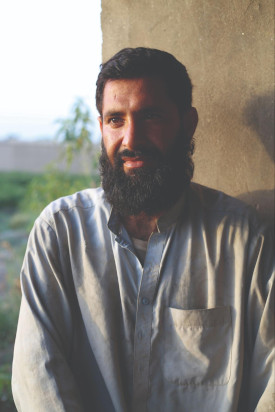
Wali Ur Rahman also farms outside of Jalalabad airfield. Rahman and his extended family all suffer from kidney problems, according to their doctors’ reports. (Photo: Lynzy Billing)
And then on top of that, you can still see the burn pits, some as big as three football fields still scorched and charred from how they were left. So there was a lack of care when they were there at the bases for both their own service members and for the entire Afghan population, but then a definite lack after they left because they don't need to, there's no requirement for them to care about the environmental damage that they had on the country.
DOERING: Yeah. What kinds of health impacts did you see on the ground while in Afghanistan? Can you tell us a story or two from Afghan civilians that really stood out to you?
BILLING: Yeah, I mean, there was a lot, a lot of stories. I spoke, I spoke to a lot of people. One thing, though, that does come up is that there's definitely a pattern with the same health problems, which very much mirror the health problems of US service members who were returning from deployment. One around Jalalabad airfield, there was a farmer and his name's Khan Mohammad. He had been working there for 20 years in a field just by the base, and his whole family helped him work in this field. And he had two sons, who were five and seven, who both have kidney problems. He had another son who had other health problems, their cousins had kidney problems, his mother had a skin rash, a persistent skin rash, and she was working the land as well in that field. And so you have this whole family working in this field where tankers are dumping sewage waste, and they're coming down with really serious kidney problems, even at the ages of five and seven.

Mohammad Taha,10, has a rash on his scalp that leaves bald itchy patches, and he has been ill since birth. His family lives outside of Jalalabad airfield. (Photo: Lynzy Billing)
DOERING: Wow.
BILLING: And they really believe that they're sick from the waste being dumped in their fields. But the reality is, is that they can't afford the medical treatment they need, or they can't afford to constantly go and see doctors. And there's really not much they can do. You know, and then you'd go to speak with a farmer next to Khan Muhammad. There was another one next to him called Wali Rahman. He had the exact same problem. He had the same kidney problems. And so doctors might say, oh, it's from the water. But then the doctors also in that area know what's happening in the area. And they know the waste is being dumped there. And they say, no, there's a pattern here. People are getting sick from the same things. They're drinking and washing in the same rivers. They're working on the same land, they're eating the food they grow in the fields. It's all connected.
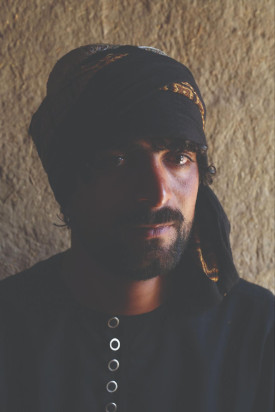
22-year-old Laal Mohammed lives less than 100 yards away from Kandahar airfield. He started having kidney problems five years ago. (Photo: Lynzy Billing)
DOERING: Yeah. And like you say, they don't really have the resources to get the medical help they need. I mean, I think in your story, there was somebody who maybe would need a kidney transplant at some point. But that's several thousands of dollars.
BILLING: Yeah. And also, you know, there's people in areas that didn't have the possibility to travel to get the medical treatment they needed before because there was ongoing fighting going on, as well. I mean, a lot of people traveled to Pakistan to get treatment just because Afghanistan doesn't have the resources or medicines available for it as well.
DOERING: I think in your story, you came upon a couple of kids who were collecting scrap metal from one of the piles of just waste that was left behind. Can you tell us about that?
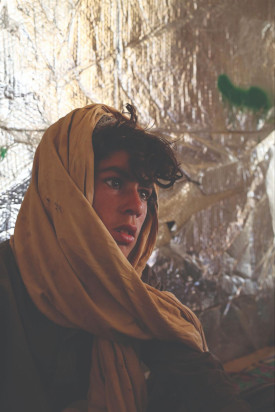
Esanullah, 15, works with his brother collecting scrap metal. He has suffered from breathing problems and rashes. (Photo: Lynzy Billing)
BILLING: Yeah, they were, had a little shop across the road from Kandahar airfields. And they'd moved there after their father had died. And they were making a living off a scrap metal collecting. And there's, outside of Jalalabad, and Kandahar and Bagram are just rows and rows of little shops, with a whole array of scrap in them, all of which comes from the base. And these two boys, you know, they had everything from broken motors and seats to Humvees to grenades, like whole grenades still, and--
DOERING: Live grenades?
BILLING: Live grenades, still like with the key hole. And, you know, unexploded artillery shells. So there's all these dangers of just them collecting these things just on top, like in the kind of backdrop of all these other things going on, you know, during the war. And there are a lot of the scrap metal collectors, not just in Kandahar, had these kinds of persistent skin rashes and problems as well. And the doctors were telling me about this also. And this is just because of the materials that they're dealing with on a daily basis.
DOERING: This is really heavy reporting, Lynzy. What keeps you going back to Afghanistan to report stories like this?
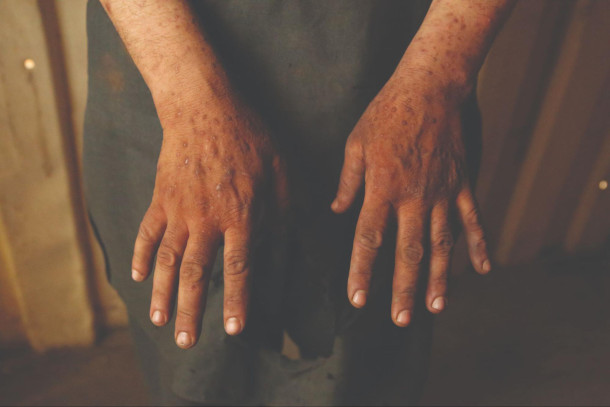
Anwar has worked as a scrap worker outside Bagram airfield for eight years. He has had a rash on his hands for six years and believes it is caused by his work. (Photo: Lynzy Billing)
BILLING: I think I'll keep going back to Afghanistan until I can't get in anymore. And it is getting harder to get in. I think that Afghanistan is a country which the effects of this kind of environmental damage and the effects of the war in general, they didn't go away when the US left in 2021. And they're still there, and people are still there waiting for answers and some level of accountability. And this is an American war in Afghanistan. And I think, especially Americans should really know about what happened there and what happened with these waste disposal practices. And also just because the US military is in so many countries around the world using the exact same waste disposal practices, and right now there is no law saying they have to clean up, there is nothing that's stopping it.

Lynzy Billing is a freelance journalist. (Photo: Lynzy Billing)
DOERING: Lynzy Billing is a freelance journalist who wrote about this for Inside Climate News and New Lines Magazine. Thank you so much, Lynzy.
BILLING: Thank you so much for having me.
Related links:
- Read Lynzy’s full story on ICN
- And in New Lines Magazine
[MUSIC: Quraishi, "Herati" on Pure & True Rubab, Evergreene Music 2014]
DOERING: Living on Earth is produced by the World Media Foundation. Our crew includes Naomi Arenberg, Josh Croom, Swayam Gagneja, Mattie Hibbs, Mazzi Ingram, Mark Kausch, Mark Seth Lender, Don Lyman, Sarah Mahaney, Aynsley O’Neill, Sophia Pandelidis, Jake Rego, El Wilson, and Jolanda Omari.
BELTRAN: Tom Tiger engineered our show. Alison Lirish Dean composed our themes. You can hear us anytime at L-O-E dot org, Apple Podcasts and Google Podcasts, and like us, please, on our Facebook page - Living on Earth. We tweet from @livingonearth. And find us on Instagram at livingonearthradio. And you can write to us at comments at loe dot org. Steve Curwood is our Executive Producer. I’m Paloma Beltran.
DOERING: And I’m Jenni Doering. Thanks for listening!
ANNOUNCER: Funding for Living on Earth comes from you, our listeners, and from the University of Massachusetts, Boston, in association with its School for the Environment, developing the next generation of environmental leaders. And from the Grantham Foundation for the protection of the environment, supporting strategic communications and collaboration in solving the world’s most pressing environmental problems.
ANNOUNCER 2: PRX.
Living on Earth wants to hear from you!
Living on Earth
62 Calef Highway, Suite 212
Lee, NH 03861
Telephone: 617-287-4121
E-mail: comments@loe.org
Newsletter [Click here]
Donate to Living on Earth!
Living on Earth is an independent media program and relies entirely on contributions from listeners and institutions supporting public service. Please donate now to preserve an independent environmental voice.
NewsletterLiving on Earth offers a weekly delivery of the show's rundown to your mailbox. Sign up for our newsletter today!
 Sailors For The Sea: Be the change you want to sea.
Sailors For The Sea: Be the change you want to sea.
 The Grantham Foundation for the Protection of the Environment: Committed to protecting and improving the health of the global environment.
The Grantham Foundation for the Protection of the Environment: Committed to protecting and improving the health of the global environment.
 Contribute to Living on Earth and receive, as our gift to you, an archival print of one of Mark Seth Lender's extraordinary wildlife photographs. Follow the link to see Mark's current collection of photographs.
Contribute to Living on Earth and receive, as our gift to you, an archival print of one of Mark Seth Lender's extraordinary wildlife photographs. Follow the link to see Mark's current collection of photographs.
 Buy a signed copy of Mark Seth Lender's book Smeagull the Seagull & support Living on Earth
Buy a signed copy of Mark Seth Lender's book Smeagull the Seagull & support Living on Earth

